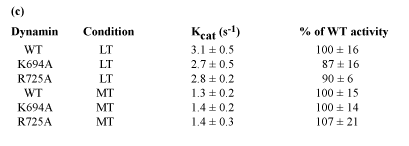|
Analysis of the R725A and K694A dynamin mutants.
|
||
|
||
| A detailed analysis of the R725A and K694A GED mutants of dynamin has previously been published by Sever et. al. 1. In this study they reported the GTPase activity of these mutants to be the same as that of WT when the dynamin is not oligomerised, but crucially R725A only has approximately 10% of WT activity when oligomerised (in that study microtubules were used as a template for oligomerisation under low ionic strength conditions). Sever et. al. reported that this mutant and the K694A mutant, though impaired in GTPase activity, stimulated ‘endocytosis’ of transferrin when over-expressed in BHK cells1. (In fact what was measured in this paper was vesicle budding and not the complete budding and scission event.) As a result of this, Sever et. al. concluded that dynamin’s GTPase activity (stimulated by oligomerisation) is not essential for endocytosis. Additionally as inhibition of GTP hydrolysis resulted in an increase in endocytosis, they concluded that the GTP bound form of dynamin is a positive regulator of endocytosis. On the basis of these conclusions, Sever et. al. propose that dynamin acts like a conventional G-protein; the GTP bound state being the ‘on’ state which recruits downstream effectors, GTP hydrolysis switching dynamin ‘off’. In a subsequent paper Sever et. al. have shown that R725A mutant of dynamin accelerated the formation of constricted coated pits 2. We have assayed the GTPase activity of R725A and K694A dynamin both on lipid tubules at physiological ionic strength (approx. 150mM) and on microtubules at low ionic strength (the conditions used by Sever et. al.). Under both of these conditions we found that R725A dynamin exhibited GTPase activity equivalent to that of WT dynamin under the same conditions (Figure 1s). We have found this to be the case both with WT and R725A dynamins expressed using virus supplied by Dr. Sandra L. Schmid and with those generated independently by ourselves. Both mutant and WT dynamin expression constructs were sequenced several times and additionally the constructs were isolated from virus after protein expression and sequenced to verify their identities. At present we have no direct explanation for the difference between our findings and those published by Sever et. al. We would however assert that our positive result, demonstrating that R725A and K694A have WT levels of GTPase activity, is less likely to be artefactual than a negative result (no activity), which could have a number of explanations e.g. degraded or mis-folded protein. The numerous GTPase defective mutants that we have identified demonstrate that our assay does effectively detect inhibited mutants. On the basis of our data, we strongly dispute that R725A and K694A dynamin provide any evidence in support of the hypothesis that dynamin is a regulatory GTPase. We simply find that it has normal GTPase activity and consistent with this, when over-expressed in COS cells, transferrin uptake levels after 30min are as high as those are when WT dynamin is over-expressed and the initial rates of uptake are not significantly different (data not shown). It has previously been proposed that the GED domain of dynamin is involved in oligomerisation3,4 and indeed mutations of the GED domain (including R725A) retard the tubulation phenotype of T65A dynamin (Fig. 2). This supports the R725 residue of dynamin as being important in oligomerisation. Thus, in our experiments R725A has a phenotype that is only unmasked in the presence of other mutations. |
||
|
References
1. Sever, S., Muhlberg, A. B. & Schmid, S. L. Impairment of dynamin's GAP domain stimulates receptor-mediated endocytosis. Nature 398, 481-486 (1999). 2. Sever, S., Damke, H. & Schmid, S. L. Dynamin:GTP controls the formation of constricted coated pits, the rate limiting step in clathrin-mediated endocytosis. J Cell Biol 150, 1137-1148 (2000). 3. Muhlberg, A. B., Warnock, D. E. & Schmid, S. L. Domain structure and intramolecular regulation of dynamin GTPase. EMBO J. 16, 6676-6683 (1998). 4. Okamoto, P. M., Tripet, B., Litowski, J., Hodges, R. S. & Vallee, R. B. Multiple distinct coiled-coils are involved in dynamin self-assembly. J Biol Chem 274, 10277-10286 (1999). 5. Herskovits, J. S., Burgess, C. C., Obar, R. A. & Vallee, R. B. Effects of mutant rat dynamin on endocytosis. J. Cell Biol. 122, 565-578 (1993). 6. Owen, D. J. et al. Crystal structure of the Amphiphysin-2 SH3 domain and its role in prevention of dynamin ring formation. EMBO J. 17, 5273-5285 (1998). 7. Binns, D. D. et al. The mechanism of GTP hydrolysis by dynamin II: a transient kinetic study. Biochemistry 39, 7188-7196 (2000). 8. Hinshaw, J. E. & Schmid, S. L. Dynamin self-assembles into rings suggesting a mechanism for coated vesicle budding. Nature 374, 190-192 (1995). 9. Warnock, D. E., HInshaw, J. E. & Schmid, S. L. Dynamin self-assembly stimulates its GTPase activity. J. Biol. Chem. 271, 22310-22314 (1996). |
||
